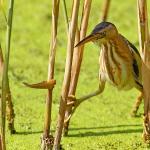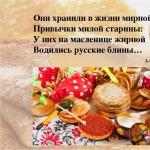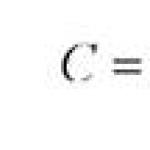Presentation of a lesson on the topic "Type of Sponge" (7th grade) presentation for a biology lesson (7th grade) on the topic. Presentation on biology "Type of Sponge", biology, grade 7 Presentation on biology on the topic of sponges
Purpose of the lesson: to introduce students to the main features of the organization of representatives of the Sponge type.
- Educational: consider representatives of the Sponge type, note the primitive features of their structure and life activity; show their role in nature and human life.
- Educational: create conditions for awareness and comprehension of a block of new educational information, application of knowledge and skills in educational situations.
- Educational: to form among schoolchildren a cognitive interest in the process of studying various types of animals; to promote a caring attitude towards nature and friendly interpersonal relationships.
Type of lesson: using multimedia.
Lesson methods: explanatory and illustrative.
Lesson type: learning new knowledge.
Equipment: computer, multimedia projector, tables, illustrations of sponges, presentation.
Lesson plan:
- Organizational moment.
- Setting goals and objectives.
- Learning new material.
- Consolidation of the studied material.
- Homework.
Lesson Plan
1. Organizational moment.
- Greetings
- Preparing the class for work
- Availability of students
2. Setting goals and objectives.
From shallow coastal waters to the murky depths of the sea, one can find strange creatures of nature - sponges. Their appearance and structure are so unusual that for a long time scientists could not decide whether they were plants or animals. The Latin name for sponges translates to “porous animals.”
Today in the lesson we will get acquainted with the wonderful world of sponges, learn the features of their external and internal structure, consider their diversity and role in nature and human life ( Presentation. Slide 2).
3. Studying new material.
The body shape of sponges is extremely diverse. They often take the form of crusty, cushion-shaped, or lumpy growths and growths on stones, mollusk shells or some other substrate. Often among them there are also more or less regular spherical, goblet-shaped, funnel-shaped, cylindrical, stalked, bushy and other forms. The sponges do not move and do not react to the strongest stimuli. Still, sponges are a special type of the animal kingdom ( Slide 3).
The shape of the sponge resembles a two-layer bag or glass ( Slide 4), the outer layer of which (ectoderm) consists of flat surface cells, and the inner layer (endoderm) contains cells with flagella that independently catch particles of food and water drawn in through the pores. Thus, it is obvious that sponges do not have a single digestive system, as well as other organs and tissues.
Sponges are protected passively - due to spiny skeletal crystals ( Slide 5).
Life processes:
1. Breathing. (Slide 6). Like most animals that live in the aquatic environment, sponges use oxygen dissolved in water for respiration. The flow of water, penetrating into all cavities and channels of the sponge, supplies nearby cells and mesoglea with oxygen and carries away the carbon dioxide they secrete. Thus, gas exchange with the external environment is carried out in sponges directly by each cell or through the mesoglea.
2. Nutrition. Sponges feed mainly on the remains of dead animals and plants suspended in water, as well as small single-celled organisms.
3. Selection. Undigested food remains are released into the mesoglea and gradually accumulate near the outlet canals, and then enter the lumens of the canals and are discharged out.
Consequently, the main vital functions of sponges are carried out in an extremely primitive way. In the absence of special organs, the processes of respiration, nutrition and excretion occur intracellularly, due to the activity of individual cells.
4. Reproduction. ( Slide 7). Sponges reproduce asexually (budding) and sexually.
5. Regeneration. ( Slide 8). The ability to regenerate is well expressed - they easily restore the integrity of the body after significant damage.
The Sponge type is divided into three classes. ( Slide 9)
Sponge type.
- Class Calcareous sponges.
- class Ordinary sponges.
- class Glass sponges.
Class Calcareous sponges. ( Slide 10)
Exclusively sea sponges, usually living at shallow depths. They are rather delicate organisms, solitary or colonial, rarely exceeding 7 cm in height. Their body often has a tubular, barrel-shaped or cylindrical shape. Sometimes a stalk is formed, with the help of which the sponge is attached to the substrate.
Class Ordinary sponges. ( Slide 11)
More than 95% of all sponge species belong to this class. The skeleton is silicon. They live in both sea and fresh water.
Class Glass sponges. ( Slide 12)
Glass sponges are peculiar marine, mainly deep-sea sponges, reaching 50 cm in height or more. Their body is most often goblet-shaped, bag-shaped or tubular, soft and easily torn like fragile felt, or with more significant development of the skeleton - quite hard and brittle. The color is grey, brown, white or yellowish. Usually solitary, less often colonial organisms.
Meaning of Sponges. ( Slide 13)
- food for aquatic animals;
- I make jewelry;
- used for medical purposes;
- used for technical purposes;
- toilet sponge is a hygienic material.
Conclusions to the lesson. ( slide 14)
- Sponges are multicellular aquatic animals.
- They lead an attached lifestyle.
- They are biofilters.
- There is a skeleton consisting of calcareous or silicon needles.
- Tissues and organs are missing.
- They reproduce asexually and sexually.
- Capable of regeneration.
- There are 8000 species.
4. Consolidation of the studied material.
Sponge Type Test. ( Slide 15)
Decide which statement is true. Write down the numbers of the correct statements.
- Sponges are the most primitive multicellular organisms.
- All sponges have tissues and organs.
- Almost all sponges have a mineral or organic skeleton.
- Sponges have the ability to regenerate.
- The entire body of the sponge is riddled with pores.
- Water enters and leaves the sponge body through the pores.
- The body of sponges consists of two layers of cells: ectoderm and endoderm.
- The flagellar cells in the inner layer of the sponge capture food, which is then digested inside them.
- Sponges are biofilters.
- Mesoglea is a layer of superficial cells.
5. Homework. ( Slide 16)
Read the textbook text on pp. 99–100 (part 1). Answer the questions in the “Test Your Knowledge” section.
List of used literature.
- Biology. 7th grade: lesson plans based on the textbook V. B. Zakharova, N. I. Sonina/aut.-state M. V. Vysotskaya.– Volgograd: Teacher, 2006
- Biology. Diversity of living organisms. 7th grade. At 2 p.m. Part 1: tutorial. for educational institutions / V.B. Zakharov, N.I. Sonin.– M.: Bustard, 2008. – 141 p.
- Thematic and lesson planning in biology: 7th grade: to the textbook V.B. Zakharova, N.I. Sonina"Biology. Diversity of living organisms. 7th grade” / N.Yu. Zakharova.– M.: Publishing house “Exam”, 2008. – 254 p.
- Sharova I. Kh. Zoology of invertebrates: book. For the teacher. – M.: Enlightenment. 1994.
- Encyclopedia for children. Biology. T2. M.: Avanta+, 2001.
To use presentation previews, create a Google account and log in to it: https://accounts.google.com
Slide captions:
Sponge Type
Habitat, way of life 1. Fresh or marine waters 2. Attached; single and colonial p.22-23
Structure. Body shape. Double-layered *ectoderm (outer layer) - flat epithelial cells *endoderm (inner layer) - flagellar cells
Nutrition Filters Small plankton, dead parts of plants and animals Water is sucked through the pores → flagella retain food, pseudopods capture → water is excreted through the mouth?1. What are the benefits of filtration? 2. Why do sponges eat this way?
Breathing with the surface of the body
Release by all cells through contractile vacuoles
Variety of badyaga sponges
basket of Venus
sponge vase
With the flow of water, nutrients are brought to the sponges and metabolic products are removed. Therefore, sponges develop best in places with intense changes in surrounding water. What adaptations should sponges have developed that live in seas with strong currents?

SPONGE TYPE
Sponges - the most primitive multicellular invertebrate animals. Zoologists suggest that they originated from colonial flagellates. The modern fauna includes more than 5 thousand species. Sponges are mainly marine animals attached to the bottom and underwater objects. They often form colonies. Organs and tissues they don't have. Almost all representatives of this type have a mineral or organic skeleton.
Sponge body shape resembles a glass or bag. The entire body of the sponge is riddled with pores. Through them, water with dissolved oxygen and floating small organisms penetrate into the sponge, which the sponge uses as food. Water comes out of the sponge through the outlet - mouth, located at the free end of the body.


Class Calcareous sponges (Calcispongia) They have a calcareous skeleton and live only in the seas, usually in shallow waters. Small sponges. Class Glass sponges (Hyalospongia) Relatively large, deep-sea sea sponges, usually solitary. They have a silicon skeleton of needles of various shapes, which, when soldered, form a lattice. Class Common sponges (Demospongia) The skeleton is silicon or organic, most often formed by a combination of both. This includes toilet sponges and freshwater sponges - badyagi. They are large in size and live at different depths.


Outer layer – ectoderm – consists of flat surface cells. Inner layer – endoderm – built from flagellated cells, similar to the cells of colonial flagellates. These cells capture food, which is then digested inside them. In addition, special mobile amoeboid cells of the inner layer also capture food and digest it. Digestion at sponges intracellular , There is no digestive system yet. Between the outer and inner layers of cells there is a gelatinous substance - mesoglea. Cells of different functions are scattered in it: amoeboid cells that serve for digestion, mature and immature gametes, skeletoblasts, i.e. cells that form the skeleton. The latter, in representatives of various species, is built from organic matter or from one-, three-, or four-axial calcareous and flint needles located in the mesoglea.

Sponges reproduce asexually (budding) and sexually. They have a well-expressed ability to regeneration – they easily restore the integrity of the body after significant damage.


In nature, sponges play a significant role as biofilters. It has long been noted that in water bodies with significant organic pollution, numerous colonies of sponges develop, participating in the biological purification of water. The practical value of sponges is small. A number of sea sponges, called toilet sponges, have been extracted from the bottom of the sea since ancient times and, after drying, are used for washing. A sponge is found in our fresh waters tramp, forming growths on underwater objects. She's being used in folk medicine as an external antirheumatic agent and for whitening and cleansing the skin. This effect of sponges is based on the irritating effect of waste products and the mechanical effect on the tissue of the skeletal formations of sponges.


Questions and tasks 1. What type are the most primitive multicellular organisms? 2. From what organisms and when did sponges originate? 3. Where do sponges live? Why do you think sponges did not come to land along with rhinophytes? 4. Tell us about the appearance and internal structure of sponges. 5. What kind of skeleton do sponges have? What is mesoglea? List the chemicals that form the skeleton of sponges. 6. How do sponges eat and digest? 7. What is the role of sponges in nature? How does a person use sponges? 8. Why are the capabilities of single-celled animals in developing new habitats and food sources limited? 9. How do you think the cells of multicellular organisms differ from the cells of unicellular organisms? Why?
Sponge type
Compiled by: Bobrovskaya E.V.


Sponge type
Sponges are extremely unique Animals. Their appearance and body structure are so unusual that for a long time they did not know whether to classify these organisms as plants or animals. In the Middle Ages, for example, and even much later, sponges, together with other similar “dubious” animals (bryozoans, some coelenterates, etc.), were placed among the so-called zoophytes, i.e., creatures seemingly intermediate between plants and animals. Subsequently, sponges were looked at either as plants or as animals. Only in the middle of the 18th century, when they became more familiar with the life activity of sponges, was their animal nature finally proven. In contrast to a colony of protozoa, consisting of more or less uniform and independent cells.


Sponge type
Class Glass sponges
Class Lime sponges
Class Ordinary sponges







Sponge nutrition
According to their feeding method, sponges are filter feeders.
1 - paragastric cavity, 2 - mouth,
3 - choanaocytes (collar endoderm cells), 4 - ectoderm,
5 - needles of the mineral skeleton,






Sponge Regeneration
If the body of an adult sponge is pressed through the mesh tissue, then all the cells will separate from each other, as if sifted through a sieve. If you then place all these individual cells in water and carefully, thoroughly mix, completely destroying all the connections between them, then after some time they begin to gradually come closer together and reunite, forming a whole sponge, similar to the previous one.







Freshwater badyaga
Of the numerous family of sponges, only one genus is found in fresh water - the freshwater sponge, or thistle. This sponge is a spongy mass, white with a green tint, attached to stones, tree branches, or generally any solid object under water. This is her appearance. If we look at it through a microscope, we will distinguish two masses: one solid - the skeleton and the other gelatinous, enveloping this skeleton. The first consists of flat siliceous needles, which are arranged in such a way that several needles form something like a column, with their tips lying at a certain obtuse angle. These points, invisible while the sponge lies in the water, appear immediately as soon as it is taken out of the water.

Using the badyagi
Bodyaga is sold in pharmacies in packages of 50-100 grams. Bodyaga masks are indeed widely used in cosmetic practice for the treatment of acne, resorption of subcutaneous hemorrhages (bruises), exfoliation of freckles, chloasma and other pigmentation. Causing a sharp hyperemia, bodyaga resolves infiltrates, dries out pustular rashes, causes peeling of the skin, thereby eliminating pigment spots - traces of former acne.

Using a toilet sponge
Since ancient times, at least since ancient times, a toilet sponge has been used by humans to wash the body. Later, in the Middle Ages, it also began to be used in medicine in the form of tampons to stop bleeding and in the treatment of diseases of the thymus gland. In the latter case, the burnt sponge preparation was prescribed as an internal remedy. The effect of such a drug is quite understandable, since the horny substance of the sponge contains iodine. At that time, the causes of goiter were not yet known, and the medicinal properties of the burnt sponge were established exclusively experimentally.

Using glass sponges
Some glass sponges have a very beautiful and graceful skeleton. The skeleton of such sponges, cleared of organic matter, is used as decoration and souvenirs. The already mentioned basket sponge of Venus is especially beautiful. Her skeleton looks like a delicate openwork cylinder of such an intricate and delicate structure that it seems to have been made by a skillful human hand. They say that the first copy of this sponge, brought to Europe, was bought for the fabulous sum of 600 marks. And to this day, the basket of Venus is considered a very valuable decoration.


The structure of sponges
Three types of sponge structure
Skeletal spines of sponges


Sponge taxonomy
limestone
ordinary
glass

The importance of sponges in nature and human life
1. Serve as food for aquatic animals.
2. They are a habitat for small animals.
3. Purify the water.
4.Used in medicine, perfumery, for polishing parts and as fertilizer.
Freshwater sponge

Answer the questions:
1.What is the main feature of the body structure of sponges?
2.Can we say that sponges are multicellular animals?
3.What is the importance of sponges to the aquatic animal community and fish farming?
4.How does a person use animals of this type?

.
- Sponges are biofilters.

Decide which statement is true.
Write down the numbers of the correct statements .
- Sponges are the most primitive multicellular organisms.
- All sponges have tissues and organs.
- Almost all sponges have a mineral or organic skeleton.
- Sponges have the ability to regenerate.
- The entire body of the sponge is riddled with pores.
- Water enters and leaves the sponge body through the pores.
- The body of sponges consists of two layers of cells: ectoderm and endoderm.
- The flagellar cells in the inner layer of the sponge capture food, which is then digested inside them.
- Sponges are biofilters.
- Mesoglea is a layer of superficial cells.

Decide which statement is true.
Write down the numbers of the correct statements .
- Sponges are the most primitive multicellular organisms.
- All sponges have tissues and organs.
- Almost all sponges have a mineral or organic skeleton.
- Sponges have the ability to regenerate.
- The entire body of the sponge is riddled with pores.
- Water enters and leaves the sponge body through the pores.
- The body of sponges consists of two layers of cells: ectoderm and endoderm.
- The flagellar cells in the inner layer of the sponge capture food, which is then digested inside them.
- Sponges are biofilters.
- Mesoglea is a layer of superficial cells.

Decide which statement is true.
Write down the numbers of the correct statements .
- Sponges are the most primitive multicellular organisms.
- All sponges have tissues and organs.
- Almost all sponges have a mineral or organic skeleton.
- Sponges have the ability to regenerate.
- The entire body of the sponge is riddled with pores.
- Water enters and leaves the sponge body through the pores.
- The body of sponges consists of two layers of cells: ectoderm and endoderm.
- The flagellar cells in the inner layer of the sponge capture food, which is then digested inside them.
- Sponges are biofilters.
- Mesoglea is a layer of superficial cells.

Decide which statement is true.
Write down the numbers of the correct statements .
- Sponges are the most primitive multicellular organisms.
- All sponges have tissues and organs.
- Almost all sponges have a mineral or organic skeleton.
- Sponges have the ability to regenerate.
- The entire body of the sponge is riddled with pores.
- Water enters and leaves the sponge body through the pores.
- The body of sponges consists of two layers of cells: ectoderm and endoderm.
- The flagellar cells in the inner layer of the sponge capture food, which is then digested inside them.
- Sponges are biofilters.
- Mesoglea is a layer of superficial cells.

Decide which statement is true.
Write down the numbers of the correct statements .
- Sponges are the most primitive multicellular organisms.
- All sponges have tissues and organs.
- Almost all sponges have a mineral or organic skeleton.
- Sponges have the ability to regenerate.
- The entire body of the sponge is riddled with pores.
- Water enters and leaves the sponge body through the pores.
- The body of sponges consists of two layers of cells: ectoderm and endoderm.
- The flagellar cells in the inner layer of the sponge capture food, which is then digested inside them.
- Sponges are biofilters.
- Mesoglea is a layer of superficial cells.

Lisitsyna Olga Anatolyevna,
teacher of the highest qualification category, MKOU "Belogorsk Secondary School No. 3" of the Republic of Crimea of the Russian Federation
















Scientific classification
Domain: Eukaryotes
Animal Kingdom

Classes of Sponges
Limestone
Ordinary
Homoscleromorpha
Six-beam

- - a type of aquatic (mainly marine) multicellular animals. Sponges are characterized by a modular structure, often associated with the formation of colonies, as well as the absence of true tissues and germ layers

- Deprived:
- muscular,
- nervous,
- digestive systems


Lime sponges
- About 500 species have been described, about 20 in the CIS seas. Calcareous sponges have been known since the Early Cambrian, with a welded skeleton - from the Permian; the greatest flourishing occurred in the Cretaceous period


Ordinary sponges
- include most representatives of the type - about 6000 species,
- most species live in the sea,
- representatives of seven families switched to life in fresh water bodies,
- the most famous freshwater sponges are badyagi,
- in the fossil record, common sponges have been known since the Cambrian; reached its greatest prosperity in the Jurassic and Cretaceous periods.











Homoscleromorpha
- There are about 100 species, divided into seven genera and two families,
- viviparity is typical: the fertilized egg develops in the mesochyl of the mother's body to the stage of a free-swimming larva - zinctoblastula


- Mostly solitary, typically oceanic organisms, usually living at depths of more than 100 m
- The body is saccular, tubular, goblet-shaped or barrel-shaped, up to 2 m in height.
- The skeleton consists of six-armed silicon needles (hence the name);

- the rays lie in three mutually perpendicular planes,
- Some of the spines have one or more rays reduced.
- Channels penetrating the walls of the body (canal system) are of a simplified leukonoid type.
- About 500 species; in the CIS seas there are 34 species, of which 6 are in the northern seas and 28 in the Far Eastern seas



- The skeleton of the Venus basket is one of the most beautiful among all glass sponges. It has the appearance of a delicate openwork cylinder with a thin and intricate structure. The first copy of this sponge brought to Europe, according to some sources, was purchased for 600 marks, a huge amount at that time. And to this day, the basket of Venus is considered a very valuable decoration.





- In a number of calcareous sponges, there was an increase in the size of the flagellar chambers and a reduction in the system of afferent and efferent canals. Such sponges consist of a tube or branched system of tubes, lined with choanocytes on the inside; in this case, the pores (ostia) open directly into the flagellar chambers. The aquifer system is characteristic of only two genera - Leucosolenia and Clathrina.

- The formation of the sicon is caused by the growth of the mesochyl and the invagination of sections of the paragastric cavity into it, forming radial tubes. Choanocytes line only the flagellar tubes and disappear from other parts of the atrial cavity. The walls of the sponge's body thicken, and afferent canals are formed between the surface of the body and the flagellar tubes. The syconal type structure is characteristic of only a few species (for example, Scypha and Grantia).

- The most complex type of structure. These are colonial sponges with numerous osculums. The thick mesogly layer contains many skeletal elements. The body wall is penetrated by a network of channels connecting numerous flagellar chambers



- 1. Deep-sea forms of sponges up to 50 cm high. Skeletal spines contain silicon. Body color is white, gray, yellow or brown.
- 2. Natural, correct arrangement of body parts relative to the center in multicellular animals.
- 3. Sponges with a calcareous skeleton, living in the shallow waters of seas and oceans. The color is yellow-gray.
- 4. The way of life of the animal when it is fixedly attached to the substrate (rock bottom or large object).

- 5. A sponge used by humans in medicine to treat rheumatism, bruises, and bruises.
- 6. Sponges with a silicon skeleton. The coloring is varied. They can reach sizes up to 1 meter.
- 7. A single-celled algae found in the cytoplasm of sponges that provides it with oxygen.
- 8. Cells that perform an individual function.
- 9. Skeletal formations present in the gelatinous substance of the body of sponges.



Questions for the crossword puzzle “Type of Sponge”
- Horizontal :
- 2. What type of sponge is used for hygiene purposes?
- 8. Sponges with a silicon skeleton. varied coloring. can reach sizes up to 1 meter
- 10. What forms the outer layer of the body?
- 13. What can sponges do quickly?
- 14. How do sponges most often reproduce?
- 17. Absent in sponges. . . system

- Vertical :
- 1. Relative constancy of chemicals. composition is this?
- 3. What cells does the sponge use to feed itself?
- 4. Single-celled algae found in the cytoplasm of sponges, providing it with oxygen
- 5. Some types of sponges can move behind which cells?
- 6. Sponges with a calcareous skeleton, living in the shallow waters of seas and oceans. color yellow-gray
- 7. What is another name for sponges?
- 9. Some types of sponges. . . forms
- 11. The animal’s lifestyle when it is fixedly attached to the substrate (rock bottom or large object)
- 12. What type of sponges are they?
- 15. What is at the top end of the sponge?
- 16. A sponge used by humans in medicine to treat rheumatism, bruises, bruises






